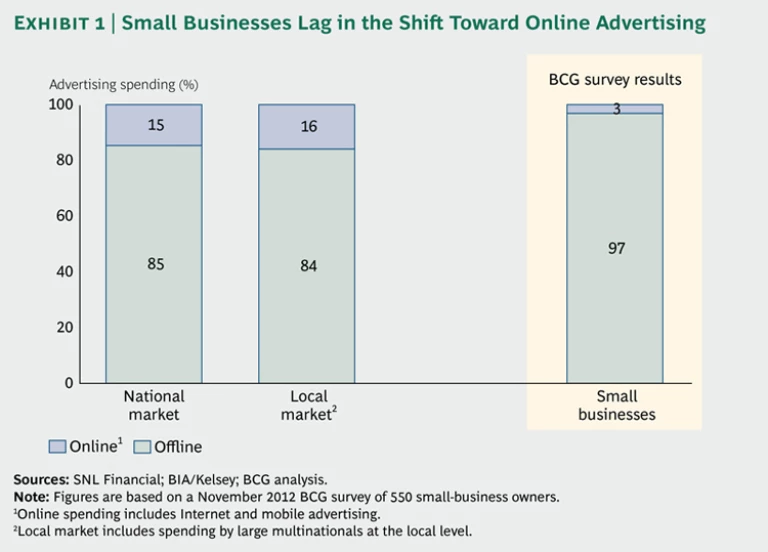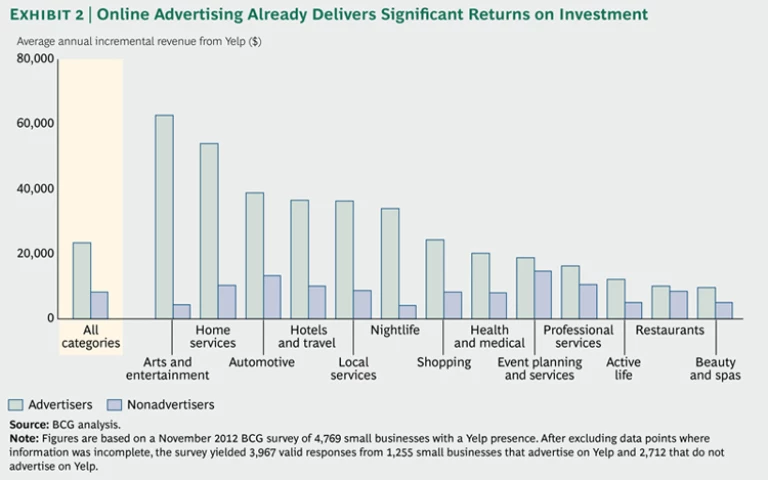Twenty-three million small businesses power the U.S. economy. They account for half of all sales in the United States today and have created two-thirds of all net new jobs since the 1970s.
But these companies are not leaders in the online-advertising world. A survey of 550 small-business owners by The Boston Consulting Group found that only 3 percent of their advertising budgets flows online. Small-business advertising dollars are still primarily spent on traditional marketing vehicles, such as Sunday circulars and coupon mailers. (See Exhibit 1.)
Further, the survey found that many small-business executives are not fully aware of all the digital-advertising options available to them. And to the extent that they are aware of those options, they are often not sure what to do with them. This is why digital-advertising activity in the U.S. is driven by large companies.
These findings may come as a surprise, given the explosive growth that digital marketing has experienced in social media and mobile communications and how important the digital economy has become. The findings also stand in contrast to numerous surveys showing that a sizable percentage of small businesses promote themselves widely online—from websites and e-mail to Facebook and Twitter. But our survey suggests that when it comes to actually spending their advertising dollars, small businesses continue to favor very traditional channels.
Digital content and online-advertising companies, therefore, still struggle to effectively serve the advertising needs of small businesses and to bring their digital spending into balance with the rest of the industry.
The Challenges of Small-Business Advertising
For many providers of local digital-advertising and marketing services, small businesses represent not only a great opportunity but also a major challenge. Mom-and-pop shops dot the local landscape. But targeting such a highly distributed and fragmented population is a challenge. It’s also difficult to convert small businesses to new marketing models at scale.
In addition, most small businesses operate the old-fashioned way, with little recognition of the Internet as a channel or a source of leads. Many small-business owners are not even aware that they have an online profile that they could be actively managing on many popular sites. For instance, only 15 percent of the small-business owners in our survey knew that they had a free Yelp profile, and only 11 percent had already claimed it.
Small businesses do spend money on their own websites, which constitute their primary digital-marketing mechanism. But what they earmark for other online advertising is fairly negligible. The small businesses in our survey reported spending anywhere from $63 to $196 per month on the following options, in order of popularity: Google, other search engines, Yelp, Facebook, Yahoo! Local, YP.com (formerly yellowpages.com), Twitter, LinkedIn, and Superpages.com.
Furthermore, small-business owners base their advertising decisions on limited research, and few employ full-time staff to manage their advertising spending. In fact, our survey showed clearly that most decisions are made on information gathered by word of mouth: the pizza parlor owner talks to a friend at the coffee shop across the street.
In addition, owners perform only the most basic—and sometimes misleading—return-on-investment analyses to learn how effective their decisions have turned out to be. The majority of small businesses we surveyed used qualitative or rough estimates of topline impact for tracking ad effectiveness.
In short, small businesses haven’t yet found their digital-marketing footing, and they have neither the time nor the capabilities to invest in doing so.
How Early Adopters Are Seizing the Opportunity
Digital-marketing-services businesses that can figure out how to access this largely untapped market could gain enormous value. Some leading-edge companies, in fact, have already moved into local markets and begun generating digital results for their customers.
Consider the case of Yelp, a local search company based in San Francisco. According to the findings of a BCG survey of nearly 4,800 small businesses, companies that had a Yelp profile but did not advertise on the site nevertheless reported generating incremental revenues of $8,000 from Yelp annually—a kind of passive halo effect.
The return is even more powerful for small businesses that actively shaped their digital presence through advertising campaigns on Yelp. The survey found that those companies achieved an average uplift in annual revenue of more than $23,000.
The results of our second survey also demonstrated the varying effects of online advertising. Arts and entertainment, home services, automotive, hotels and travel, local services, and nightlife, for example, achieved the most significant revenue impact from Yelp. (See Exhibit 2.)
The survey thus highlights the need for companies to adopt targeted approaches, and it underlines a key message for local advertising and online-marketing-services providers. Digital-marketing-services businesses that can navigate the small-business market and help small companies recognize the tangible benefits of advertising will capture significant growth for both themselves and their customers. To achieve that goal, however, such providers should take a few lessons to heart.
Tailor your offers and pricing strategies to the customer. The needs of small businesses, the results they achieve, and their levels of sophistication all vary by category and industry. Companies that want to seize the opportunity to sell local online advertising should customize their offers and associated pricing according to their clients’ needs, the verticals they occupy, and the value they deliver.
For a category such as quick-service restaurants, for instance, that might mean creating a bundled offer of check-in deals and coupons. Note that the same bundle may not be as relevant for a business in another category, such as home services, which might not have as many repeat purchasers.
Embrace advocacy-based marketing. The small-business marketplace comprises a large number of companies that spend relatively little on online advertising. That structure, coupled with word-of-mouth referrals, means that companies should focus on using referrals—especially from key people in the industry—to drive small businesses to their doorsteps. This is true even for the few organizations that have local feet-on-the-street sales capabilities.
Strategies that use LinkedIn, Facebook, and Twitter to harness the power of brand advocates, therefore, are proving to be more effective than traditional marketing tools, such as outbound call-center phone messages, door-to-door sales, and direct e-mail marketing.
Help small-business owners see the tangible benefits of online advertising and promotion. Established companies and startups alike are developing dashboards of information about the effectiveness of their online advertising efforts. Presented in a meaningful and user-friendly way, this information allows companies to make better marketing decisions. The Holy Grail of digital advertising is to help large and small businesses clearly view their spending practices across channels and to give them a reliable and credible metric for calculating the payback on their online-marketing investments, regardless of the advertising vehicles they use.
Some of the near-term opportunities will involve broad-based tools that go beyond simplistic ROI analyses. For instance, companies that learn how much a given offer changed the average basket size at purchase or how many check-ins or queries were generated from a particular ad could improve the effectiveness of their promotions. Methods such as these will allow small businesses to turn what has been an underexplored territory into a source of competitive advantage.
Companies that can redirect the billions of dollars of small-business-advertising spending toward digital marketing will unlock enormous value. And the opportunity benefits everyone: successful campaigns will simultaneously fuel the growth of small businesses and media and marketing companies—if both players can learn to leverage local advertising.
Note: The survey, designed and analyzed by BCG’s Center for Consumer and Customer Insight , was conducted at the suggestion of local search firm Yelp, which contributed to the costs associated with fielding the survey by a third-party market research company. The survey findings and conclusions are solely the work of BCG.







